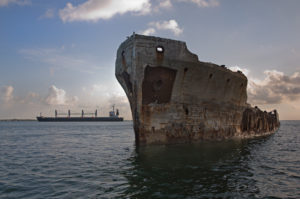
A close-up of the bow of the SS Selma (Creative Commons license attribution: photo courtesy Louis Vest)
If you’ve been on the ferry between Port Bolivar and Galveston Island…or you’ve been on Pelican Island, visiting Seawolf Park…or if you’re flying over Galveston Bay at a high altitude…or even, if you look in the right spot using Google Earth, you can see Galveston’s most famous shipwreck.
The SS Selma had earned its place in history before it found its permanent home near Pelican Island. It was a reinforced concrete oil tanker, built because steel was in short supply during the World War I years (1914-18), and because marine engineers believed a such a ship could function efficiently.
The ship was 420 feet long, had a displacement of 7,500 tons, and a crew of 49. Launched in 1919, it made several successful voyages. In 1920, the Selma hit a jetty in Tampico, Mexico, and sustained a 60-foot long gash. The ship was towed to Galveston for repairs. Unfortunately, Galveston at that time lacked both the expertise and specialized facilities to make the necessary repairs to a concrete ship. The decision was made to dispose of the ship.
The Selma was towed out to Galveston Bay where a 25-foot-deep trench had been dug for her final resting place. The ship was set into the trench, and she rests there today.
Seawolf Park on Pelican Island has a state historical marker commemorating the Selma. But there’s more to the story.
What to do with a shipwreck both easily visible and accessible from Galveston? Efforts were made to make it into a fishing pier, a pleasure resort, and later, an oyster farm. All were unsuccessful. It did become a popular fishing spot.
Rumors abounded that a German spy lived aboard the shipwreck during World War II. In 1946, a local man, Frenchy LeBlanc, bought the Selma with the intention of living there. He died in 1964 and the Selma eventually passed into the hands of A. Pat Daniels, a longtime newspaper reporter and editor. He wrote a book, Bolivar! Gulf Coast Peninsula that came out in 1985 but is out of print today. During his research, he began learning about the Selma and shared its stories with others.
The cliché “out of sight, out of mind,“ does not apply to the Selma. It will always be a local curiosity that fascinates those who observe it.
